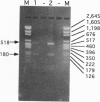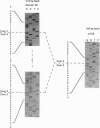Abstract
An isoform of the estrogen receptor messenger RNA (ER-mRNA) was identified in RNA from the brain of lizards and rats. Poly(A)+ RNA from brain and uteri was reverse transcribed using gene-specific primer for the ER. The resulting complementary DNA was amplified in a polymerase chain reaction followed by cloning and sequencing of the amplified products. This isoform lacks exon four and is designated delta 4 ER-mRNA. Although several isoforms of the ER have been described from cancerous cells, to our knowledge, none has been identified previously in the brain. Furthermore, the delta 4 isoform is the only isoform detected in normal tissue. The delta 4 isoform appeared most abundant in RNA from brain tissue, whereas uterine RNA contained only trace amounts of the isoform. Apparently, tissue-specific alternative splicing accounts for these differences in abundance. Because exon four encodes a part of the steroid-binding domain, we predict that the corresponding protein encoded by the isoform will not bind estradiol and may therefore belong to a growing subclass of the steroid/thyroid/vitamin superfamily known as orphan receptors. We predict that the putative delta 4 protein may function as a ligand-independent transcription factor that acts on the same DNA response elements as the conventional ER. The abundance of this isoform in the brain relative to the uterus raises fundamental questions regarding the regulation of estrogen-responsive genes in different tissues.
Full text
PDF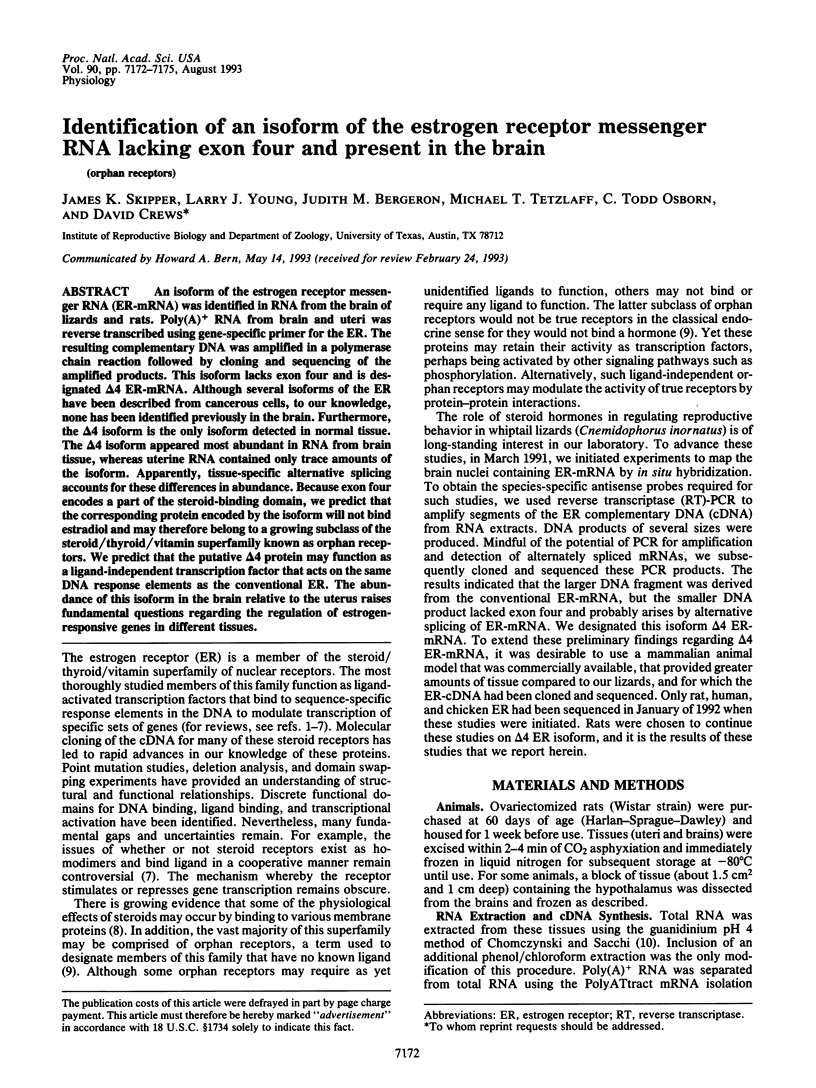
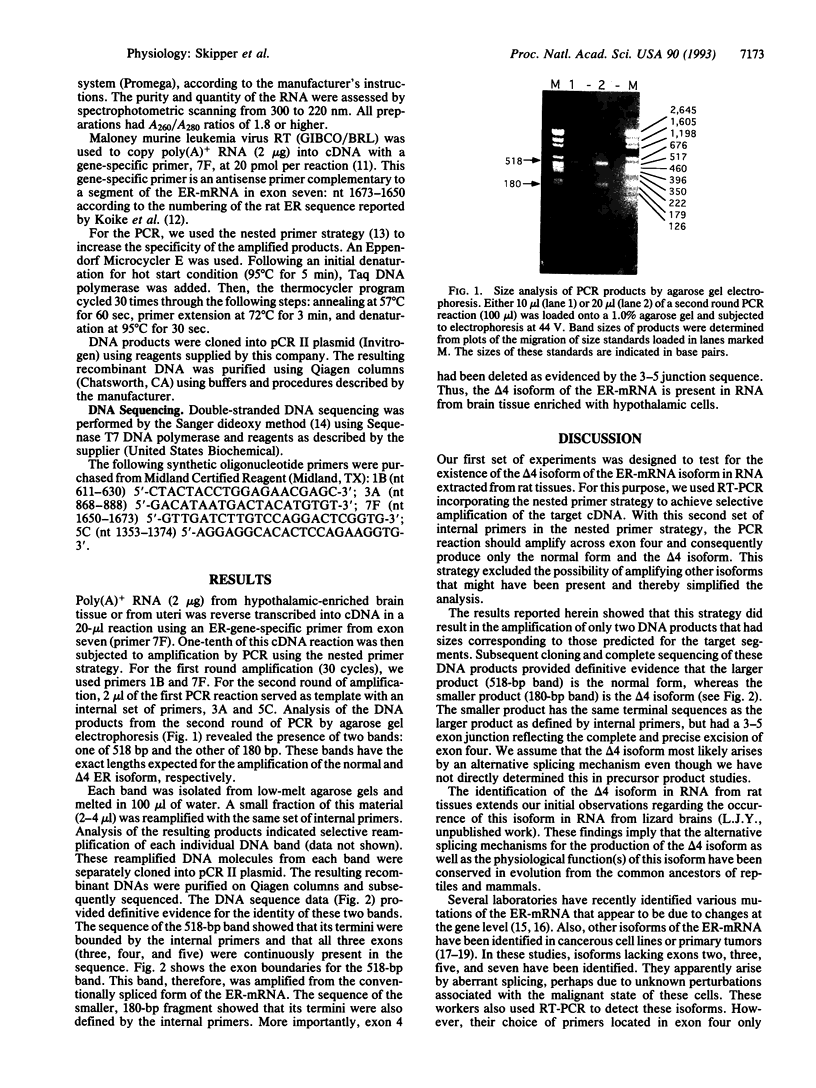
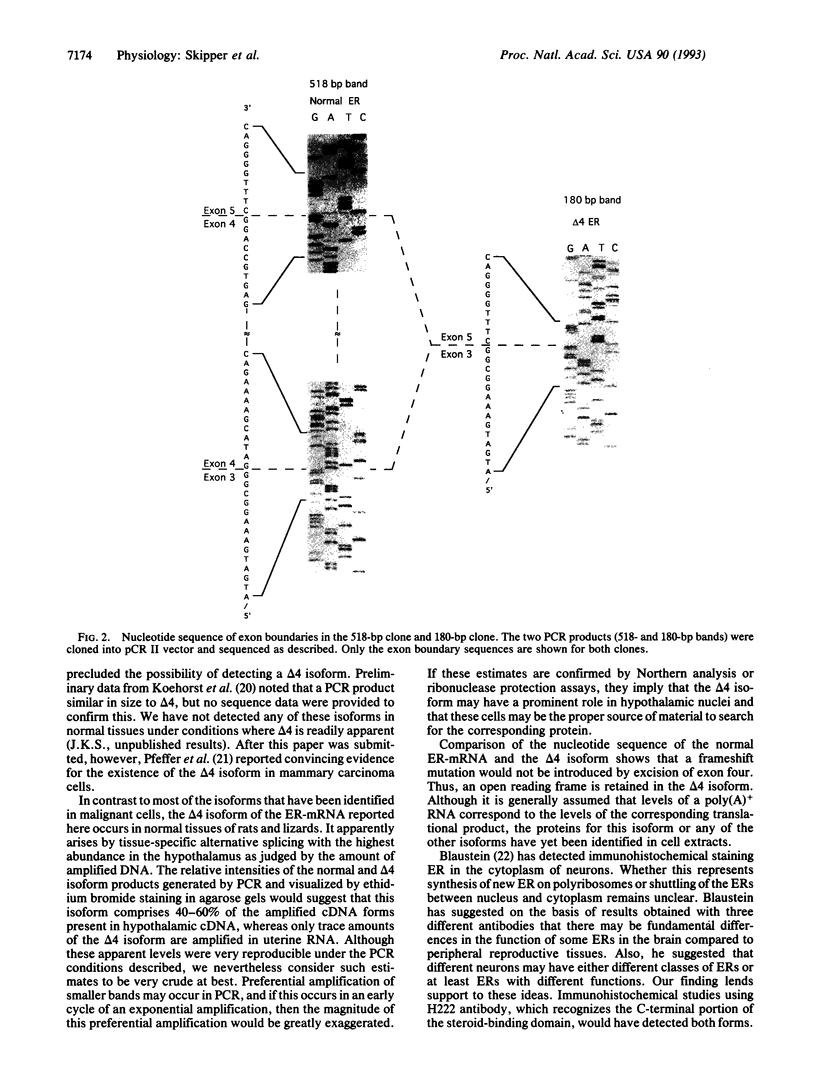
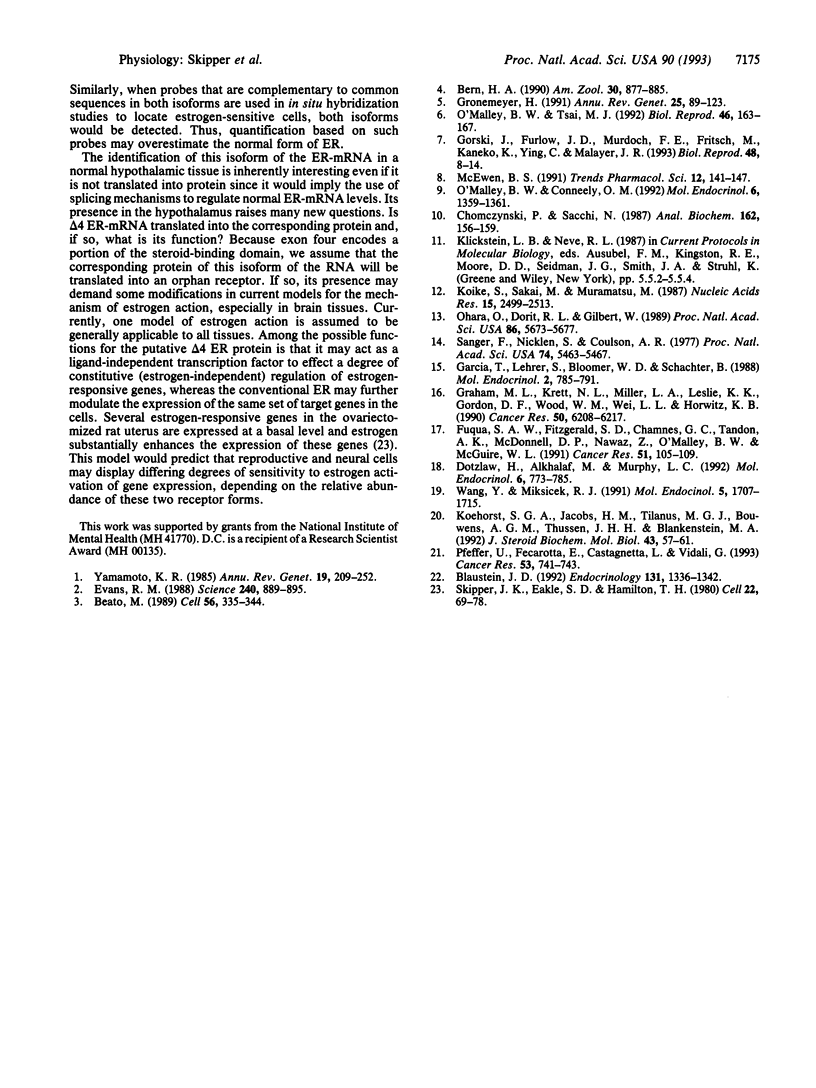
Images in this article
Selected References
These references are in PubMed. This may not be the complete list of references from this article.
- Beato M. Gene regulation by steroid hormones. Cell. 1989 Feb 10;56(3):335–344. doi: 10.1016/0092-8674(89)90237-7. [DOI] [PubMed] [Google Scholar]
- Blaustein J. D. Cytoplasmic estrogen receptors in rat brain: immunocytochemical evidence using three antibodies with distinct epitopes. Endocrinology. 1992 Sep;131(3):1336–1342. doi: 10.1210/endo.131.3.1380440. [DOI] [PubMed] [Google Scholar]
- Chomczynski P., Sacchi N. Single-step method of RNA isolation by acid guanidinium thiocyanate-phenol-chloroform extraction. Anal Biochem. 1987 Apr;162(1):156–159. doi: 10.1006/abio.1987.9999. [DOI] [PubMed] [Google Scholar]
- Dotzlaw H., Alkhalaf M., Murphy L. C. Characterization of estrogen receptor variant mRNAs from human breast cancers. Mol Endocrinol. 1992 May;6(5):773–785. doi: 10.1210/mend.6.5.1603086. [DOI] [PubMed] [Google Scholar]
- Evans R. M. The steroid and thyroid hormone receptor superfamily. Science. 1988 May 13;240(4854):889–895. doi: 10.1126/science.3283939. [DOI] [PMC free article] [PubMed] [Google Scholar]
- Fuqua S. A., Fitzgerald S. D., Chamness G. C., Tandon A. K., McDonnell D. P., Nawaz Z., O'Malley B. W., McGuire W. L. Variant human breast tumor estrogen receptor with constitutive transcriptional activity. Cancer Res. 1991 Jan 1;51(1):105–109. [PubMed] [Google Scholar]
- Garcia T., Lehrer S., Bloomer W. D., Schachter B. A variant estrogen receptor messenger ribonucleic acid is associated with reduced levels of estrogen binding in human mammary tumors. Mol Endocrinol. 1988 Sep;2(9):785–791. doi: 10.1210/mend-2-9-785. [DOI] [PubMed] [Google Scholar]
- Gorski J., Furlow J. D., Murdoch F. E., Fritsch M., Kaneko K., Ying C., Malayer J. R. Perturbations in the model of estrogen receptor regulation of gene expression. Biol Reprod. 1993 Jan;48(1):8–14. doi: 10.1095/biolreprod48.1.8. [DOI] [PubMed] [Google Scholar]
- Graham M. L., 2nd, Krett N. L., Miller L. A., Leslie K. K., Gordon D. F., Wood W. M., Wei L. L., Horwitz K. B. T47DCO cells, genetically unstable and containing estrogen receptor mutations, are a model for the progression of breast cancers to hormone resistance. Cancer Res. 1990 Oct 1;50(19):6208–6217. [PubMed] [Google Scholar]
- Gronemeyer H. Transcription activation by estrogen and progesterone receptors. Annu Rev Genet. 1991;25:89–123. doi: 10.1146/annurev.ge.25.120191.000513. [DOI] [PubMed] [Google Scholar]
- Koehorst S. G., Jacobs H. M., Tilanus M. G., Bouwens A. G., Thijssen J. H., Blankenstein M. A. Aberrant oestrogen receptor species in human meningioma tissue. J Steroid Biochem Mol Biol. 1992 Sep;43(1-3):57–61. doi: 10.1016/0960-0760(92)90187-n. [DOI] [PubMed] [Google Scholar]
- Koike S., Sakai M., Muramatsu M. Molecular cloning and characterization of rat estrogen receptor cDNA. Nucleic Acids Res. 1987 Mar 25;15(6):2499–2513. doi: 10.1093/nar/15.6.2499. [DOI] [PMC free article] [PubMed] [Google Scholar]
- McEwen B. S. Non-genomic and genomic effects of steroids on neural activity. Trends Pharmacol Sci. 1991 Apr;12(4):141–147. doi: 10.1016/0165-6147(91)90531-v. [DOI] [PubMed] [Google Scholar]
- O'Malley B. W., Conneely O. M. Orphan receptors: in search of a unifying hypothesis for activation. Mol Endocrinol. 1992 Sep;6(9):1359–1361. doi: 10.1210/mend.6.9.1331771. [DOI] [PubMed] [Google Scholar]
- O'Malley B. W., Tsai M. J. Molecular pathways of steroid receptor action. Biol Reprod. 1992 Feb;46(2):163–167. doi: 10.1095/biolreprod46.2.163. [DOI] [PubMed] [Google Scholar]
- Ohara O., Dorit R. L., Gilbert W. One-sided polymerase chain reaction: the amplification of cDNA. Proc Natl Acad Sci U S A. 1989 Aug;86(15):5673–5677. doi: 10.1073/pnas.86.15.5673. [DOI] [PMC free article] [PubMed] [Google Scholar]
- Pfeffer U., Fecarotta E., Castagnetta L., Vidali G. Estrogen receptor variant messenger RNA lacking exon 4 in estrogen-responsive human breast cancer cell lines. Cancer Res. 1993 Feb 15;53(4):741–743. [PubMed] [Google Scholar]
- Sanger F., Nicklen S., Coulson A. R. DNA sequencing with chain-terminating inhibitors. Proc Natl Acad Sci U S A. 1977 Dec;74(12):5463–5467. doi: 10.1073/pnas.74.12.5463. [DOI] [PMC free article] [PubMed] [Google Scholar]
- Skipper J. K., Eakle S. D., Hamilton T. H. Modulation by estrogen of synthesis of specific uterine proteins. Cell. 1980 Nov;22(1 Pt 1):69–78. doi: 10.1016/0092-8674(80)90155-5. [DOI] [PubMed] [Google Scholar]
- Wang Y., Miksicek R. J. Identification of a dominant negative form of the human estrogen receptor. Mol Endocrinol. 1991 Nov;5(11):1707–1715. doi: 10.1210/mend-5-11-1707. [DOI] [PubMed] [Google Scholar]
- Yamamoto K. R. Steroid receptor regulated transcription of specific genes and gene networks. Annu Rev Genet. 1985;19:209–252. doi: 10.1146/annurev.ge.19.120185.001233. [DOI] [PubMed] [Google Scholar]



